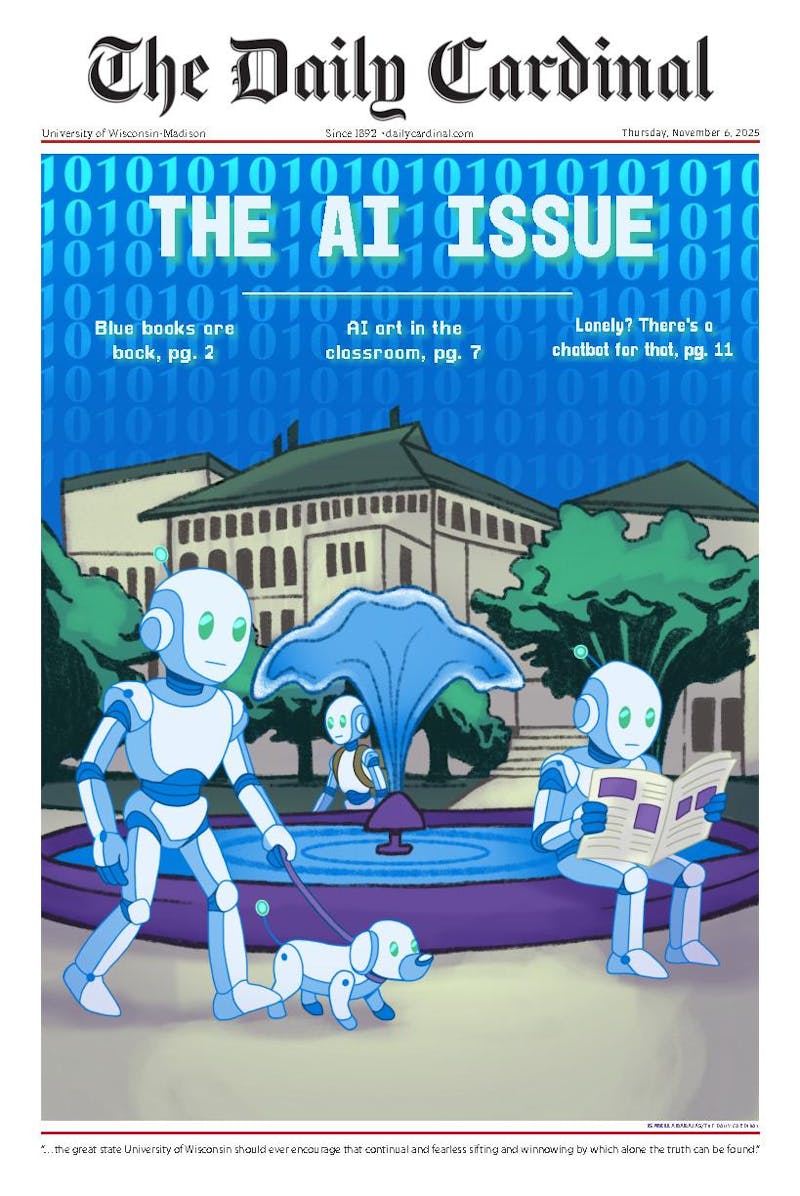American history has seen changes in the attitudes of the general population toward war and those soldiers who fight on the front lines. Veterans of war have faced criticism at times, but the Wisconsin Veterans Museum, 30 W. Mifflin St., has dedicated its space to honoring those who have fought for their country.
According to museum director and historian Richard Zeitlin, the museum was established to commemorate, acknowledge and affirm the role of Wisconsin veterans in America's military past.
In the years just following the start of the Vietnam War, the American social climate was marked by tension between student protesters and soldiers. Presently, the American attitude is significantly more patriotic than in the time prior to the tragedy the nation faced in September, although history professor John Sharpless said Sept. 11 tragedy simply galvanized a trend that was present.
\We are in a different time period than in the years of the Vietnam War,"" Sharpless said. ""Following Vietnam, there was an alienation between veterans and students, but it has been a long time since I have sensed that. I think the world has changed. The world was changing, and Sept. 11 has accelerated that change.""
During the era of Vietnam War protests, the soldiers themselves were seen as the enemy, with less focus on the political figures behind the fighting men and women. However, according to Sharpless, this attitude has changed during the current time of unrest.
""[In the 1970s,] the actual soldier in the field was blamed when they were doing their duty,"" Sharpless said. ""Now I sense more and more students empathize personally with soldiers. They're [the student's] age. ... You very seldom hear people criticize soldiers.""
Zeitlin has another view of the Wisconsin Veterans Museum's mission.
""Personally, I feel it is important that people be reminded of the services and sacrifices people had to make to protect us and the freedoms we take for granted,"" Zeitlin said.
With artifacts from every war since the Civil War and life-like dioramas, the museum illustrates the trials and triumphs of Wisconsin soldiers. The visitor experiences the battle of Antietam, war in the South Pacific, the bitter cold of ""The Bulge""during World War II and the diversity of the troops in Vietnam.
The Wisconsin Veterans Museum honors Wisconsin soldiers by educating the public about battles and wars in which Wisconsin troops made an impact.
The year 2001 marked the Wisconsin Veteran's Museum's centennial. The museum began in 1901 as a memorial to Wisconsin soldiers who participated in the Civil War. The museum was not limited to displays about the Civil War, as founders intended the museum to commemorate Wisconsin troops that served in later wars.
""The museum was established to commemorate and acknowledge the Wisconsin soldiers from the Civil War and any subsequent war,"" Zeitlin said.
Originally, the museum simply consisted of a display in the State Capitol controlled by the Grand Army of the Republic, a group of veterans from the civil war. The museum remained a major display in the Capitol for 90 years. In 1989, renovations in the Capitol called for the departure from its previous location, and the current museum was constructed between 1990 and 1993 and opened in June 1993.
The museum is divided into three galleries. Two galleries cover the last two centuries and the third gallery displays temporary exhibits. Since the museum was founded to honor Civil War veterans, the Civil War has the most coverage throughout the museum. Also covered in the 19th century gallery is the Spanish-American War. The 20th century gallery contains displays about the Mexican Border Campaign, World War I, World War II, the Korean War, Vietnam and Desert Storm. The changing exhibits gallery currently features military intelligence and the rise of veterans' organizations.
A statue of a drummer from the Union Army greets those entering the 19th century gallery. The drummer is depicted as a young man and the visitor immediately senses the youth of the armed forces. The statue is flanked on the left by a diorama of the Battle of Antietam.
The Antietam diorama is the centerpiece of the museum. This presentation portrays the battle by placing the viewer on the front lines of the Union forces. The diorama depicts Wisconsin's famed Iron Brigade playing an integral part in the Union's key victory at Antietam. The Wisconsin troops trudged through what later became known as ""The Cornfield"" on their way to defeat one of Confederate Gen. Stonewall Jackson's units. The diorama captures the action from the battle and shows the sacrifices Wisconsin soldiers made to hold America together.
The entrance to the 20th century gallery shows a World War II ""Mustang"" soaring above. On the left, a World War I Sopwith ""Camel"" is suspended. On the right, a Vietnam War ""Huey"" helicopter stalks the enemy. Straight ahead is the best display of the gallery, a diorama of two of the great World War II battles.
""The World War II display was intended to contrast the jungles of Asia with the cold winters of Europe,"" Zeitlin said.
The diorama presents these contrasts by displaying scenes from the Buna Campaign in the South Pacific and the Battle of the Bulge in Belgium. The diorama of the Buna Campaign, which was spearheaded by Wisconsin's 32nd division of the National Guard, depicts the camaraderie of the troops as two soldiers share a water bottle. In contrast, the Bulge diorama illustrates how weather can make war even more miserable as U.S. troops lie in the snow staving off the attacking German line.
Aside from these exhibits, one could easily spend an afternoon walking through the museum and still not absorb everything. The museum has a temporary exhibit displaying some of the last remaining World War II code machines from the Germans, Japanese, and Americans.
""We encourage students to come see the museum. It is one of the best museums in the state and free to the public,"" Zeitlin said.





